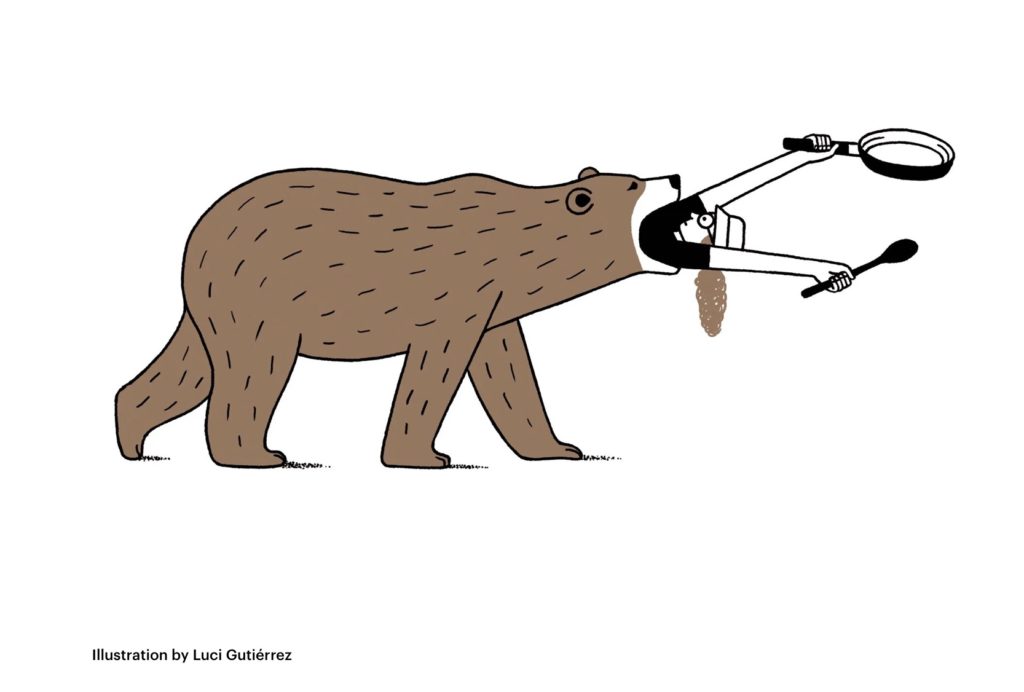Every once in a while wildlife wander into human areas.
They’re in search of two simple things: food and shelter. City limits don’t mean a thing to them. A wandering bear is no more aware of entering town than a hiker is of crossing from one wolf pack’s territory to another – neither traveler pays any mind until the steward gets aggressive.

Mountain lions slink down from the foothills in search of easy prey. Bucks in rut wander into town, throwing caution to the wind in hopes of finding a mate. Bears do all they can to get their fill before winter hibernation. Wolf packs get more aggressive. Raccoons, foxes, and opossums turn to the easiest food sources like compost piles, trash cans, and the like.
Next to giving birth, encountering a wild animal is one of the most primal experiences a person can have. We become animals. There is no reasoning with a bear. If it’s hungry and deems you to be an easy meal, you’ve got a fight on your hands. Just ask the Montana man who was attacked by a grizzly … twice in October 2016. And yet even with these stories all over the news, it’s important to remember that wild animals are different from humans.
Animals who attack are not murderers, they’re just animals. It’s what they do.
It’s our responsibility – as the species enlightened with complex thought and an upright gait – to know how to interact with wildlife in a respectful, safe, and intelligent manner.
Small Wilds
The most common wild animals that humans encounter are the little guys like foxes and opossums. They hang around humans because we make such nice warm homes. And because we make a lot of trash that they love to eat.
But don’t discount them just because they’re smaller in stature. A possum, for example, is a generally docile creature, but it won’t hesitate to bite if it feels threatened. The best course of action if you find a possum in your yard is to let it be. Don’t approach it or try to catch it.
That being said, it’s not always feasible to just let the little guys be. Anyone with chickens, a garden, or pets knows that sometimes one must set up boundaries to protect crops and critters.

Foxes are known for causing all sorts of trouble in rural areas – eating chickens, stalking pets – and yet it’s important to remember that they’re just exhibiting their natural behavior. Whatever resentment a human feels toward a wild animal is a reflection on humanity more so than the creature.
Instead of trapping a fox with an inhumane leg-hold trap, which reeks of vengeful cruelty, there are much kinder means of catching a scoundrel fox to relocate him away from one’s home. A camouflaged wire cage baited with fishy-smelling cat food, pork, or other meat can lure in even the slyest of foxes. Once the fox is caged, it can easily be released in the woods outside of town.
If trapping is not working, the Humane Society offers a whole slew of other creative ways to deter small predators like foxes:
- Leave a scent they dislike like smelly gym shoes
- Mount shiny, reflective balloons around the den
- Use a capsicum-based granular repellent
Living with small wild animals is a balancing act. We want to respect their need to thrive and at the same protect our own livelihood. With the right tools, the balance can easily be struck.
Big Wilds
Wild animals must be treated with the utmost respect and caution. When wild animals like bears, mountain lions, and wolves come into human-populated spaces like towns and cities, there are a series of questions to take into consideration: Am I in immediate danger? Is the animal behaving aggressively? Has the animal been reported to the authorities?

If no one is in immediate danger, secure your safety and report the sighting to local authorities. Getting a head start on the animal is important – a non-aggressive animal will often get tranquilized and returned to the wild, while an animal that has attacked a human will be killed on sight.
If the animal is demonstrating aggressive behavior, it’s perfectly acceptable to call 911. If he or she is just loping around town, call Fish and Game or your local wildlife hotline to report its presence. Remember, no matter where you are it is a huge gift to get to see a wild animal. Enjoy the moment.
For many of us, spending time outdoors is elemental to who we are. Whether you spend your day off foraging for mushrooms, hiking with the family, or geocaching around town or in the woods, there’s a good chance you could come across a large wild animal. It’s important to know the proper way to respond. Initially, stay calm and back out of its territory as mindfully as possible. If the animal spots you, assess the situation and take the following precautions.
Source and read on (article is much longer)
Upper illustration from https://www.newyorker.com/magazine/2018/09/17/tips-for-wild-animal-encounters